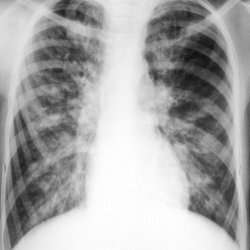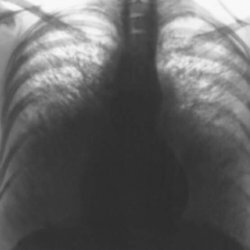Psychosocial rehabilitation of patients with pneumoconiosis at an outpatient stage of treatment
 In modern society, psychological factors play an important role in the occurrence, flow and treatment of many somatic disorders. In connection with this, active research has been carried out in the field of somatic medicine in recent decades.
In modern society, psychological factors play an important role in the occurrence, flow and treatment of many somatic disorders. In connection with this, active research has been carried out in the field of somatic medicine in recent decades.
The role of psychocorrection and psycho-prophylaxis in the treatment of patients with pneumoconiosis
During illness in humans, the nature of relationships with the surrounding world changes dramatically. And it is for this that the treatment of the disease must be considered in a comprehensive manner, that is, not only a change in its physical or psychological state, but of its entire relationship with the world as a whole.
The basis of this treatment is the concept of personality VM.Myasishchev, in it a person is a single biological, psychological and social system, and his personality is a system of relationships emotionally saturated, both with himself and with those around him. Following this system, the disease is a certain situation, the result of which is not defined and does not predict. This result can be an independent psychotraumatic factor that breaks the picture of the world, understates self-esteem, changes the order of events, changes the nature of relationships with people, and most importantly - disrupts the social functioning of the individual.
At the moment, the greatest number of studies is devoted to the study of psychosomatic features of patients with various pulmonary pathologies. In particular, there is an increasing interest in studying the quality of life in patients with pneumoconiosis. This disease is very important, both medical and social problem in modern health care, not only in our country, but also abroad.
During the development of medicine, it becomes most obvious that in order to improve the result of treatment and speedy recovery it is first necessary to carry out psychocorrection and psycho-prophylaxis. This strategy helps to obtain more valuable data on the interaction of a chronic illness with the psyche, and also helps to promote more effective therapy in the form of an individual approach and tactics for the patient, which fully applies to chronic diseases such as pneumoconiosis.
Three-stage rehabilitation program for patients with pneumoconiosis
At the moment, there is a rehabilitation program for patients with pneumoconiosis, which consists of three stages. The first stage is stationary. The patient is in the clinic, where he selects a set of optimal rehabilitation measures in accordance with the severity of the disease. These activities include individual selection of therapy products and their doses, the necessary physiotherapy procedures, massage, respiratory gymnastics, as well as psychotherapy. This observation is six months. This determines the effectiveness of treatment after three periods of time - eight, sixteen and twenty-four weeks. In the future, it is necessary to monitor the dynamics in a year. This stage of rehabilitation is based not only on medical therapy, but also on psychological rehabilitation of the patient, whose goal is medical and psychological rehabilitation and improvement of the patient's condition.
This is followed by the second stage of rehabilitation. It is necessary to carry out it in conditions of out-patient supervision under the control of specialists of the dispensary. The main task of this stage is the preservation of the patient's social activity, which was observed before the illness or its adaptation to life in community-based conditions. Therefore, the leading role in this stage is devoted to biological therapy. It is important to note that the transition to the second stage is accompanied by an increase in the impact of exogenous factors, as the patient from the hospital goes home. In this regard, it is necessary to continue to optimize therapy.
It must be remembered that psychotherapeutic and educational work should be carried out not only with patients, but also with his relatives. This helps to change the attitude of the patient not only to the disease, but also to work, as well as to his social environment, which is important. For the patient, it is necessary to highlight the positive prospects for treatment and explain that his reorientation in the work is the main characteristic on the way to recovery.
Medical therapy and its correct selection occupies an important niche, both at the second and third stage of rehabilitation. The patient and his family will have to take care of the proper adherence to the prescribed treatment regimen. It is important to emphasize that in our time a lot of patients get more than one drug, which complicates the process of compliance with the regime. It is equally important to note the existence of multiple treatment regimens for syndromes that have a similar clinic. This entails a disruption of the remission of the underlying disease at the time the patient passes to long-term treatment. Therefore, it is important to draw the attention of the patient to the prescribed dose of drugs, the nature of therapy and the biological validity of such prolonged treatment. Since the therapy for pneumoconiosis exists on the principle of "doctor-patient relationship".
It should be remembered that the meaning of this psychological correction is a person's awareness of the contradictoriness of his attitude towards the disease, which will help to solve this problem. If you eliminate the concerns caused by this event, you can restore self-regulation. Simply put, it is important to rebuild the patient's attitude, which in itself is the cause of psychogenic decompensation.
The patient needs to build the order of origin and development of the disease, and also to identify the causes of exacerbations. All this must be done together with the doctor, as in a properly constructed dialogue the patient can identify the causes of the disease and adjust their own behavior. Awareness of the reasons is a necessary condition for choosing an approach to their elimination. Here the third stage of readaptation is included. It includes a training program where the patient is given a simple formulation, without medical terms, explaining the maximum possibility of recovery, and also motivating the patient to normalize the state of health. If the patient is ready for treatment, then the work done by the specialists was successful.
Group therapy and its role in the rehabilitation of patients with pneumoconiosis
Psychological rehabilitation of patients with pneumoconiosis consists of ten sessions on psychocorrection. One lesson lasts one hour, in which forty minutes are spent studying the information about the disease and twenty minutes of self-correction. Such classes are conducted in groups of eight or ten people. While information about the disease is the same for men and women, psychological correction is somewhat different. That is why the groups are formed in accordance with the gender, and the age in them can vary. The main issue for consideration is the issue of employment, retraining and social adaptation if the patient becomes disabled. In groups it is necessary to create an atmosphere of partnership, trust and mutual understanding, for this, along with the patients, the process of education is also conducted by family members. In the classroom, the patient should be given the opportunity to talk about his fears and concerns and try to discuss them as much as possible.
It is necessary to remember about patients with inadequate reaction to their disease. For this, a special psychocorrection program is selected, which primarily affects the emotional state of the patient, which leads to increased self-confidence, relaxation and learning expressions of anger and other negative emotions.
Thus, the phased use of medication and psychocorrection therapy allows to maximize the percentage of patients with long-term remission, which leads to an improvement in the social relationship and quality of life in patients with pneumoconiosis.



